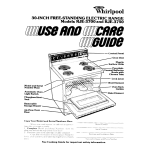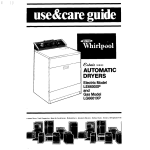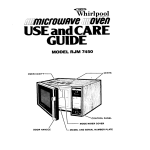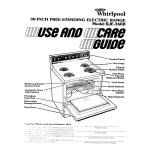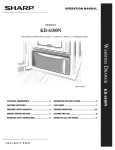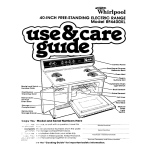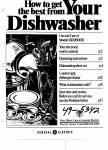Download Whirlpool RJE-3300 Specifications
Transcript
%Kirlpool 304NCH FREE-STANDING ELECTRIC RANGES Models RJE-3300 and RJE-333P Control Reflector Panel Chrome Bowls Broil Element Model and Serial Number Plate Bake Element Removable Storage Drawer Removable C opy Your Model and Serial Number Here Table of Contents BEFORE USING USING YOUR THE SURFACE RANGE UNIT Page 3 ........................... CONTROLS .................. 4 USING THE OVEN CONTROLS ........................... l Baking ................................................ l Broiling ............................................... . Variable Broil Feature ................................... . Resetting the Oven Temperature Control Knob .............. 4 4 4 5 5 OVEN 6 RACK USING THEOVEN POSITIONS THE OVEN VENT LIGHT ___.,.____.__._ ,, _____, ,.___.___ 6 ................................ 6 ......................................... SETTlNGTHECLOCKTOTHECORRECTTlMEOFDAY USING THE MINUTE TIMER .............................. ............................. THE OPTIONAL ROTISSERIE .................. YOUR CONTINUOUS CLEANING OVEN ..... 6 7 7 7 CLEANING AND CARING FOR YOUR RANGE ............. l Removing and Replacing Control Knobs ................... ............................. l Cleaning Under the Cooktop . Removing the Oven Door ................................ l Removing the Outer Oven Window ........................ l Removing the Storage Drawer ............................ l Cleaning Chart ......................................... 9 9 10 10 10 10 11 ......................... IFYOUNEEDSERVICEORHELP ............................. 1. BeforeYouCallforService .................................. 2. IfYouNeedService 3. If You Have a Problem ................................. 12 12 13 13 Oven Light Switch _) _- - .--. ,,.-“.- ..“...- ~, -_..,. 1.12 / -e Control Knob &en Selector Knob Surface Unit Control Clock Knobs Before using your range IMPORTANT This is the only fine print you’ll find in this booklet. Please read it to be sure you use your range as it was meant to be used. We build applrances to last, but we can’t control how they are used. Before using it, you are personally responsible for making sure that it l is properly installed and leveled on a floor that will hold the weight, and In a well-ventilated room. l is connected only to the right kind of outlet. with the right electric supply and grounding. l is used only for lobs expected of home ranges. l IS out of the weather. l is properly maintained. l is not used by children or others who may not understand how it should be used. 3 Using the surface unit controls The Surface Unit Control Knobs must be pushed in before turning them. This helps avoid turning them on accidentally when wiping off the Control Panel. And it helps keep small children from turning them on. You must push in on them...then PUSH IN and turn to setting. turn to the setting you want. A design by each knob tells which unit is turned on by that knob. (For example, [ %] shows that the right front unit.. the one closest to you on your right. will heat when you push in and turn‘that knob.) The knob may be set anywhere between “HI” and “OFF.” As you use your surface units, you will get used to the settings that match your pots, pans and favorite foods the best. As a guide, the setting should cook at about the following heats: HI - To start most foods cooking. To bring water to a boil. MED-HI - To hold a rapid boil; to fry pancakes or chicken. MED -To make gravy, puddings and icings; to cook large quantities of vegetables. MED-LO -To keep food cooking after starting it at a higher setting. LO -To keep food warm until ready to serve. You will notice that you can set the heat higher or lower within the LO band [$?I to help keep food at the temperature you want. The Signal Light will glow whenever a Surface Unit is on. Be sure this light is off when you have finished cooking. Using the oven controls Baking: First-Follow the directions on page 6 for “Positioning Oven Racks.” To bake, turn the Oven Selector Knob to BAKE. Second-Turn the Oven Selector Knob to “BAKE.” Third-Turn the Oven Temperature Control Knob to the baking temperature you want. The Oven Signal Light will glow while the oven is heating. When this light goes off, the oven has heated to the temperature you set. Fourth-Place food in oven. The heating elements turn off and on during baking to keep the oven at the temperature you set. The Oven Signal Light will glow when the heating elements are on. Fifth-When the baking is done, turn both the Oven Temperature and Oven Selector Knobs to “OFF.” Broiling: First-Follow the directions below for placing the meat at the right from the Broil Element. Second-Turn the Oven Selector to “BROIL.” Third-Turn the Oven Temperature Control Knob to “BROIL” or turn it to a lower temperature (see “Variable Broil Feature,” on page 5). Fourth-Put the broiler pan on the oven rack. Fifth-Keep the oven door open about four inches (10 cm). There is a stop in the hinges to hold it there. The Oven Signal Light will glow while the broil element is on. Sixth-When you are through. turn both the Oven Temperature Control and the Oven Selector Knobs to “OFF” distance To broil, turn the Oven Selector Knob to BROIL. The following chart suggests broiling times and oven-rack POsitions for different kinds of meats when the Oven Selector Knob is set to BROIL. Food Description Beef Steaks Rare .C ALWAYS broil with the door open about 4 inches (10 cm). Medium 1” (2.5 1” (2.5 cm) cm) Well done Beef Steaks 1” (2.5 cm) Rare 1%“(4cm) Medium 1%” (4 cm) 1%” (4cm) % ” ( 1 cm ) Well done Hamburgers Lamb Chops Medium Ham slice. precooked or tendered Canadian Bacon Pork Rib or Loin Well done Chicken Chop 7-9 9-11 3” (8 cm) 3” (8 cm) 3” (8 cm) 4”-5” (lo-13 4” -5” (lo-13 4” -5”(10-13 3” (8 cm) Approximate Minutes 2nd side 1st side 11-13 cm) cm) cm) 3-5 4-7 5-7 13-15 17-19 19-21 6-8 6-8 8-10 14-16 4-5 1” (2.5 cm) l/z“_1” 3” (8 cm) 6-8 4-5 (l-2.5 cm) 55” (1 cm) 3/4“. 1 ” 3” (8 cm) 3” (8 cm) 6-8 6 4-5 4 (2-2.5 cm) 2-3 lb. (1-1.5 kg) cut in half 4” -5” (lo-13 cm) 15 10 7” -9” (18-23 3” (8 cm) 3” (8 cm) cm) 25-30 11-16 7-8 10-12 9-14 5-7 3 6-7 3 4-5 Fish whole Liver fillets l/z ‘I_ 3/4 I’ (l-2 Frankfurters Inches (cm) from top of food to Broil Element cm) 3” (8 cm) 4” -5” (lo-13 cm) Variable Broil Feature: screw: NOTICE position of notches. You might want to broil some foods slower than others. Broiling can be slowed down by setting a lower temperature on the Oven Temperature Control Knob instead of “BROIL.” Using a lower temperature will cause the broil element to turn on and off during the broiling so that the food broils more slowly. When the Oven Temperature Control Knob is on “BROIL,” the Broil Element heats all the time. Set the temperature lower and it heats some of the time. The lower the temperature setting, the shorter are the periods of heating. NOTE: The Oven Selector must be in the “BROIL” position in order for the Broil Element to heat. Resetting the Oven Temperature Control Knob: Move black part toward “LO.” One notch equals about lO”F(5”C). Move black part toward “HI.” One notch equals about lO”F(5”C). Does your new oven seem hotter or colder than your old oven? The temperatures in older ovens often shift very gradually, getting hotter or colder without the user really noticing the change. Your new oven is properly adjusted to provide accurate temperatures, but when compared to your old range, the new design may give you different baking results. If you think that the temperature setting on your range needs to be hotter or colder, you can adjust the Temperature Control Knob by yourself. To adjust the setting, first pull the Oven Temperature Control Knob straight off. On the back, just across from the locking screw, are a row of notches on the black part of the knob and one tooth on the chrome part. To set your oven about lPF(5”C) cooler. remove the locking screw and move the row of notches one notch closer to “LO.” To set your oven about lO”F(5”C) warmer, move the row of notches one notch closer to “HI.” Each notch equals about lO”F(5”C). 5 Oven rack positions Your oven has two racks. Always put the racks where you want them to be before you turn on the oven. To remove a rack, take hold of it on the front edge and pull it out until it stops. Then lift up the front edge and pull again. It will slide past the stops. out of the guides and out of the oven. To put it back, fit the back comers into the guides at each side of the oven and slide it in, keeping the front tilted upuntil the rack passes the stops in the rack guides. To remove rack, pull forward until rack stops, lift front and pull. For: Place Rack: Baking On the second or third rack guide from the top.. so food is in the center of the oven. Broiling So food is about the distance from the broil element suggested in the broiling timetable under “Using the Oven Controls.” Roasting LARGE cuts of meat On the bottom Roasting SMALLER cuts of meat So food is in the center of the oven. rack guides. When baking, always leave at least 1% to 2 inches (4-5 cm) of air space between the sides of a pan and other pans and the oven wall for air circulation. For best results, get additional information on placing pans, cookie sheets and other utensils from the “Cooking Guide.” Using the oven light To turn on the oven light, push the oven light switch. Push it again to turn off the oven light. To replace the oven light bulb: Replace with a 40-watt APPLIANCE bulb. 1. Turn the electric power off at the main power supply. 2. Remove the light bulb from the socket. 3. Replace the bulb with a 40-watt appliance bulb (designed to stand up to oven heat) available at most grocery. variety and hardware stores. The oven vent There is an oven vent under the right rear surface element. When the oven is on, heated air will escape through it. A vent is needed for air circulation in the oven during baking. You can cook on this surface unit while the oven is on. A warm pan of food will stay warm on this unit while the oven is on. It may be warm enough to melt butter, too. Do not try to save heat or energy by blocking the vent. Poor baking can result. Plastic utensils may melt if they are over the vent while the oven is on. Setting the clock to the correct time of day 1. Push in the Minute Timer Knob and turn it clockwise to the correct time of day. to set the hands Clock and Timer Knob 2. The Minute Timer hand will turn as you set the is set, let the knob pop out. Then, while it is out, hand clockwise to “OFF.” If you push in on the Minute Timer, you will change the setting of the Using the Minute clock. When the clock turn the Minute Timer knob when setting the clock. Timer The small numbers inside the clock face are the minute markings. Turn the knob in the center of the clock...don’t push it in...to the number of minutes you want to time. When the time you set is up, a Minute Timer buzzer will sound. Turn the hand to “OFF’ to stop the buzzer. The Minute Timer does not start or stop cooking. It only buzzes when the time you set is up. It can be used to time almost any cooking operation. It can even remind you of other things (like when to add the softener to the washer). For the most accurate timing, turn the knob past the time you want. Then turn it back to the setting. The optional rotisserie If you would like a rotisserie with your oven, you can order a kit from your dealer. Easy installation instructions come with the kit. Your Continuous How a Continuous Liquids spread on rough surfaces: bead up on smooth surfaces. Cleaning Oven Cleaning Oven Works: A standard oven has walls with a smooth porcelain enamel finish. A Continuous Cleaning Oven also has a porcelain enamel finish with one important difference: instead of being smooth, like glass, the walls of a Continuous Cleaning Oven are a little rougher.. like the surface of a brick. A fat spatter will form a solid drop on a smooth surface. But on the rougher surface in a Continuous Cleaning Oven. a fat spatter spreads out to a very thin layer. Think of the difference between a drop of water on a piece of waxed paper and one on a paper towel. The water on the waxed paper will stay together in a bead. The water on the rougher paper towel will spread out over a larger area. This is about what happens to a fat spatter in a Continuous Cleaning Oven. Instead of a bead of fat that turns into black charred material when heated, the fat spatter spreads out. Then, when the oven is used for baking and roasting, the fat gradually bums away. The rougher surface returns to a presentably clean condition. This is a gradual process; it does not happen right away. The walls continuously clean themselves, but only when the oven is set for medium to high temperatures during baking or roasting. The oven can be presentably clean with little or no hand cleaning. ..depending on how it is used. The continuous cleaning process does not apply to uncoated parts like the oven window and oven racks. Soils that are removed...and those that are not: Fat spatters from meat roasting. oven frying and broiling are the usual oven soils. They can be continuously cleaned away most of the time. Spillovers from pies and casseroles. sugars and starches. and other soils that fall to the bottom of the oven are very hard to remove. That is why heavy-duty aluminum foil is placed on the bottom of the oven. It helps catch these spillovers and the foil can be replaced when necessary. 7 Caring for your Continuous .C Cleaning Oven: 1. Follow trusted recipes for baking, roasting and broiling. They will give time. temperature and pan recommendations to help avoid smoke. spatter and spillovers. 2. Keep heavy-duty aluminum foil on the bottom of the oven. If foil is not used, and something permanent stain. spills over, it may leave a 3. The oven racks should be kept clean with hot sudsy water. Use a soapy steel-wool pad or plastic scouring pad to remove stubborn spots. Rinse well and dry with a soft cloth. 4. The oven window should also be kept clean with hot. sudsy water. Do not use a soapy steel-wool pad on the window. Rinse well and dry with a soft cloth. Replacing aluminum ,. foil on the oven bottom: You can use the heavy-duty 18-inch (45 cm) aluminum foil found in most grocery stores. Or you can order an aluminum foil kit (Part Number 241430) from your Whirlpool Dealer. 1. When cutting the foil, make sure it is long enough to cover the bottom with enough left over to start up both sides. 2. Make sure the bake element is cool. Lift it far enough to raise its feet from the bottom of the oven. (You may have to remove an oven rack.) 3. Slide the foil sheet under the bake element. Make sure it is centered and long enough to start up the sides. 4. When you put the bake element back down, make sure all the feet rest solidly on the foil and that the foil is smoothed out across the bottom of the oven. If the feet on the element are not solidly on the foil, the oven may not bake properly. If results aren’t what you expect: Remember, the oven keeps itself presentably clean at normal baking temperatures. If you do very little baking, but a lot of broiling, you may see fat spatters on the oven walls and door. This is because broiling will add new spatters faster than old ones can be burned off. In some cases, you may want to clean the oven by hand. Foil should lay flat in bottom of oven and should not touch the heating element. Hand-cleaning the Continuous Cleaning Oven: 1. Wash with hot, soapy water and rinse well. 2. Use a soapy steel wool pad or plastic scouring pad for more stubborn spots. 3. Do not use commercial oven cleaners. These cleaners may collect in the rough porcelain-enamel finish. The fumes from commercial oven cleaners trapped in the porcelain-enamel surface may be harmful. NOTE: The oven door is ventilated to help keep the outside cooler. This also means that the inside of the oven door does not get as hot as the oven walls. Because of this, some hand-cleaning of the door may be needed...especially if the oven is used mostly for broiling or at low baking temperatures. Cleaning (_,._m ryI . i: __ -* *, *_: @ ._/*-e ‘A” Pull knob and trim ring straight out. Remember how ihe spring goes. and caring for your range Your range is designed to be easy to clean. You will usually wipe off spills and spatters when they happen, but you will sometimes want to clean under and behind the control knobs and surface units, This section will tell you how to remove those, and what to use when cleaning. Removing and replacing surface unit control knobs: 1. 2. 3. .*- 4. 5. Be sure the control knobs are set to “OFF.” Pull straight out on the black knobs. If the control has a chrome trim ring, pull it straight out. Wash the knobs (and trim rings) in warm, sudsy water. Replace the trim rings first. If the control spring was removed, put it back exactly as shown on the left...small 6. Hold the black knob so it points to “OFF.” end first. Push it straight back on. Removing and Replacing Oven Control Knobs: 1. 2. 3. 4. Be sure the knobs are set to “OFF.” Pull each knob straight off. Wash the knobs in warm, sudsy water. The knobs are not interchangeable. Make sure you put the adjustable Oven Temperature Control Knob on the right place, and the nonadjustable Oven Selector Knob on the other. Removing surface units and reflector bowls: To remove surface unit, lift and pull straight out. 1. First, be sure the Surface Unit Controls are all “OFF” and surface units are cool. 2. See where the surface units plug into the range? Lift each unit about an inch (2.5 cm) at the edge away from the (receptacle). Pull the unit straight away from the plug-in. that the surface plug-in Do not wash surface units; they will burn themselves clean during normal use. 3. Lift out the reflector bowls. Hold surface unit level when replacing. Replacing reflector bowls and surface units: 1. Be sure the surface unit controls are on “OFF.” 2. Put the reflector bowls back into their places. Make sure you can see the plug-ins (receptacles) for the surface units through the square hole in the side of each bowl. 3. Hold the surface unit level with the prongs (terminals) pointing at the plug-in. 4. With the prongs started in the plug-in, start pushing in on the surface unit. At the same time, lift a little on the side of the surface unit that’s by the plug-in. 5. Make sure the surface-unit prongs are pushed into the plug-in as far as they will go. The surface unit will fit into the reflector bowl and be level when everything has been done right. 9 Prop up the top with support rod. Cleaning under the cooktop: To clean the area under the cooktop, lift the front of the cooktop at r. Raise the swing-up rod to hold it. (Be sure the tip of the rod is ch in the cooktop.) Use warm soapy water and a sponge or cloth. powders or any other abrasive cleaner may harm porcelainishes and can scratch chrome. e careful not to raise the cooktop so high that it touches the control console. And don’t drop it. Dropping the cooktop can chip or crack a hard porcelain finish. or damage side panels and surface units. Removing the oven door: Pull straight with the angle of part-open door. Removing the oven door may make it easier to clean the oven. To remove the door. first open it to the first stop (about 4 inches or 10 cm). Take hold of both sides of the door near the top; then lift it at the same angle it is in. With the door off, you will notice how the ends of the hinges slide into slots at the bottom corners of the door. To put the door back on, fit both bottom corners of the door over the ends of the hinges. Push the door down evenly, so neither comer gets ahead of the other. When it reaches the bottom. you can close the door. A safety latch will hold the door open until it is on correctly. Removing the outer oven window: If your oven door has a window instead of the full-width black glass, the outer glass and frame can be removed for cleaning between the two. It is held on by screws at the top, and tabs hidden at the bottom. Do not try to take apart an oven door with full-width glass. Push down evenly. Remove screws; swing out top. Lift up at bottom. Pull to stop. Lift; pull again. 10 1. With the oven door closed, remove the screws from the top outer window frame. 2. Tip the frame out about two inches (5 cm) from the door. frame and glass are one piece, so don’t worry about coming apart.) 3. Lift up on both sides of the frame to pull the tabs out of the the bottom of the window opening. To replace the frame and glass, line up the bottom of the with the opening in the door. 1. Tilt the frame so that the tabs fit into the slot at the bottom window opening. 2. Tilt the frame as far as you can and push down. 3. Push the frame in the rest of the way and replace the screws. of the (The them slot at frame of the Removing the storage drawer: The drawer Never keep anything below your oven is meant to store pots and pans. in there that will burn or melt. You may want to remove the drawer for cleaning under the range. Pull it straight out until it stops. Lift the front and pull some more to get it over the stop. Now slide it out until it stops again. Lift the drawer away from the range until it slips out of the guides. To put it back, fit the side rails at the back of the drawer into both guides on the range. Push it closed while lifting the front to get past the stops. PART WHAT Outside of appliance Soft cloth, warm soapy water l Wipe off regularly Nylon or plastic scouring for stubborn spots l Do not allow food containing acids (such as vinegar, tomato, lemon juice or milk) to remain on surface. Acids will remove the glossy finish. l Do not use abrasive l Spatters or spills will burn off. l Wipe off excessive spills with damp cloth when surface unit is cold. l Do not immerse l Wash, rinse and dry well. l Do not soak. l Clean frequently. l Wash with other cooking l Do not use harsh abrasives. Surface units HOW TO CLEAN TO USE pad No cleaning required Control knobs and chrome rims Warm, sudsy water and bristle brush Chrome reflector Automatic dishwasher or warm, soapy water or plastic scrubbing pad bowls when range is cool. or harsh cleansers. in water. utensils. Aluminum broiler pan and grid Warm, soapy water or soapy steel wool pads l Wash with other cooking Control Warm, soapy water l Wash, rinse and dry with soft cloth. Oven racks Warm, soapy water or soapy steel wool pads l Wash, rinse and dry. Use soapy steel stubborn areas. Oven door glass Warm, soapy water or plastic scrubbing pad l Make certain oven is cool. Wash, rinse and dry well with soft cloth. Commercial l Follow directions Warm, soapy water or soapy scrubbing pad l Clean stubborn clean water. Heavy-duty aluminum foil available at grocery stores or order Part No. 241430 from your Whirlpool dealer or your TECH-CARE@ service representative l Place strip of aluminum catch spillovers. foil on bottom l Do not use commercial oven cleaners. panel Continuous Cleaning Oven glass cleaner utensils. provided wool pads for with cleaner. spots or stains. Rinse well with of oven to Most fat spatters on porcelain-enamel interior surface gradually reduce to a presentably clean condition during normal baking or roasting operations 11 IF YOU NEED SERVICE OR HELP. WE SUGGEST THESE THREE STEPS: YOU FOLLOW 1. Before you call for service*: following If your range does not seem to be operating before calling for service. properly. check the tf nothing operates: l l Is the range plugged into an operating outlet or tired into a live circuit with the proper voltage? (See Installation Instructions.) Have you checked the main fuse or circuit-breaker box? If the oven will not operate: l l Is the Oven Selector Knob turned to a setting (BAKE or BROIL)? Is the Oven Temperature Control Knob turned to a temperature setting? If surface units will not operate: l l l Have you checked the main fuse or circuit-breaker Are surface units plugged in all the way? Do the control knobs turn? If surface-unit l l Control Knob or Knobs will not turn: Is the spring put in correctly, as shown on page 9 and Caring for your Range” Section? Did you push in before trying to turn? If soil is visible on Continuous l l l box? in the “Cleaning Cleaning Oven finish: The special finish is designed to gradually reduce oven soil during normal baking or roasting. It is not designed to keep your oven spotless.. only presentably clean. If you broil often, you may see oven soil. The door is cooler than oven walls. Soil will be more visible on the door than other areas in the oven. See page 7 : “Your Continuous Cleaning Oven.” If cooking results aren’t what you expect: Is the range level? Are you using pans recommended in the Cooking Guide? l If baking, have you allowed 1% to 2 inches (4-5 cm) on all sides of the pans for air circulation? l Does the oven temperature seem too low or too high? See page 5, “Resetting Your Oven Temperature Control Knob.” l Have you preheated the oven as the recipe calls for? l Are the pans the size called for in the recipe? l Are you following a tested recipe from a reliable source? l Do the cooking utensils have smooth, flat bottoms? l Do the cooking utensils fit the surface unit being used? See the Cooking Guide for more information on cooking problems and how to solve them. l l 2. If you need service*: i OF QUALITY SERVICE If your WHIRLPOOL8 appliance ever needs service anywhere in the United States, help is just a phone call away. to your nearest Whirlpool franchised TECH-CARE” service representative. Whirlpool maintains a nationwide network of franchised TECH-CARE service companies to fulfill your warranty and provide afterwarranty service and maintenance to keep your WHIRLPOOL appliance in peak condition. You’ll find your nearest TECH-CARE service company listed in your local telephone book Yellow Pages under Washers/Dyers-Repairing or Servicing. Should you not find a listing, dial free, the Whirlpool COOL-LINES service assistance telephone number (800) 253-1301. When calling from: (800) 632-2243 Michigan (800) 253-1121 Alaska & Hawaii If you move... To make sure that your appliance is correctly installed and to insure its continued satisfactory operation. please telephone your nearest TECH-CARE” service company for installation or to get the name of a qualified installer. (Installation cost will, of course, be paid by you.) Helpful hints... You can help your TECH-CARE service representative give you faster service if you include the model and serial number of your appliance when requesting service. Also. retain your sales slip and warranty to verify your warranty status. Remember.. . Your TECH-CARE service representative is specially trained in the expert repairing and servicing of your WHIRLPOOL appliances. He can help you maintain the quality originally built into your WHIRLPOOL appliance. So why not take the time. now. to look up his telephone number and jot it down in the space provided on the cover. 3. If you have a problem*: Call Whirlpool Corporation in Benton Harbor at the COOL-LINE service assistance telephone number (see Step 2) or write: Mr. Stephen E. Upton. Vice President Whirlpool Corporation Administrative Center 2000 U.S. 33 North Benton Harbor. Michigan 49022 * If you must call or write. please provide: your name. address, telephone number, type of appliance, brand. model, serial number, date of purchase, the dealer’s name, and a complete description of the problem. This information is needed in order to better respond to your request for assistance. 13 : FSP is o rea~slered lrademork of WhirlpoOl Corporaiicn for quality parts. Look forlhis symbol of qwlity whenever FSP ycu need 0 replacement part 0 for your Whirlpool op&mce. FSP replacement parts will fit right and wofk right, become they ore mode lo the same exacting specifications used lo bulkt every new Whirlpool appliance. 0 Benton Harbor. Michigan. Automalic Washers. Clolhes DrverS. Freezers, Relrlgeralor-Freezers. Ice Makers. Dishwashers. Built-In Ovens and Surlace Units, Ranges. Microwave Ovens. Compactors. Room Air Conditioners. Oshumidillers. Cenlral Healmg and Air Condilioning Systems. Quality. Our way of life. Part No. 310598 Rev. 6 Printed in U.S.A.














